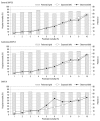Validation of the Simplified Acute Physiology Score 3 scoring system in a Korean intensive care unit
- PMID: 21155036
- PMCID: PMC3017709
- DOI: 10.3349/ymj.2011.52.1.59
Validation of the Simplified Acute Physiology Score 3 scoring system in a Korean intensive care unit
Abstract
Purpose: The Simplified Acute Physiology Score (SAPS) 3 was recently proposed to reflect contemporary changes in intensive care practices. SAPS 3 features customized equations for the prediction of mortality in different geographic regions. However, the usefulness of SAPS 3 and its customized equation (Australasia SAPS 3) have never been externally validated in Korea. This study was designed to validate SAPS 3 and Australasia SAPS 3 for mortality prediction in Korea.
Materials and methods: A retrospective analysis of the prospective intensive care unit (ICU) registry was conducted in the medical ICU of Samsung Medical Center. Calibration and discrimination were determined by the Hosmer-Lemeshow test and area under the receiver operating characteristic (aROC) curve from 633 patients.
Results: The mortalities (%) predicted by SAPS 3, Australasia SAPS 3, and SAPS II were 42 ± 28, 39 ± 27 and 37 ± 31, respectively. The calibration of SAPS II was poor (p = 0.003). SAPS 3 and Australasia SAPS 3 were appropriate (p > 0.05). The discriminative power of all models yielded aROC values less than 0.8.
Conclusion: In Korea, mortality rates predicted using general SAPS 3 and Australasia SAPS 3 exhibited good calibration and modest discrimination. However, Australasia SAPS 3 did not improve the mortality prediction. To better predict mortality in Korean ICUs, a new equation may be needed specifically for Korea.
Conflict of interest statement
The authors have no financial conflicts of interest.
Figures

References
-
- Metnitz B, Schaden E, Moreno R, Le Gall JR, Bauer P, Metnitz PG ASDI Study Group. Austrian validation and customization of the SAPS 3 Admission Score. Intensive Care Med. 2009;35:616–622. - PubMed
-
- Knaus WA, Draper EA, Wagner DP, Zimmerman JE. APACHE II: a severity of disease classification system. Crit Care Med. 1985;13:818–829. - PubMed
-
- Knaus WA, Wagner DP, Draper EA, Zimmerman JE, Bergner M, Bastos PG, et al. The APACHE III prognostic system. Risk prediction of hospital mortality for critically ill hospitalized adults. Chest. 1991;100:1619–1636. - PubMed
-
- Le Gall JR, Lemeshow S, Saulnier F. A new Simplified Acute Physiology Score (SAPS II) based on a European/North American multicenter study. JAMA. 1993;270:2957–2963. - PubMed
-
- Lemeshow S, Teres D, Klar J, Avrunin JS, Gehlbach SH, Rapoport J. Mortality Probability Models (MPM II) based on an international cohort of intensive care unit patients. JAMA. 1993;270:2478–2486. - PubMed
MeSH terms
LinkOut - more resources
Full Text Sources

